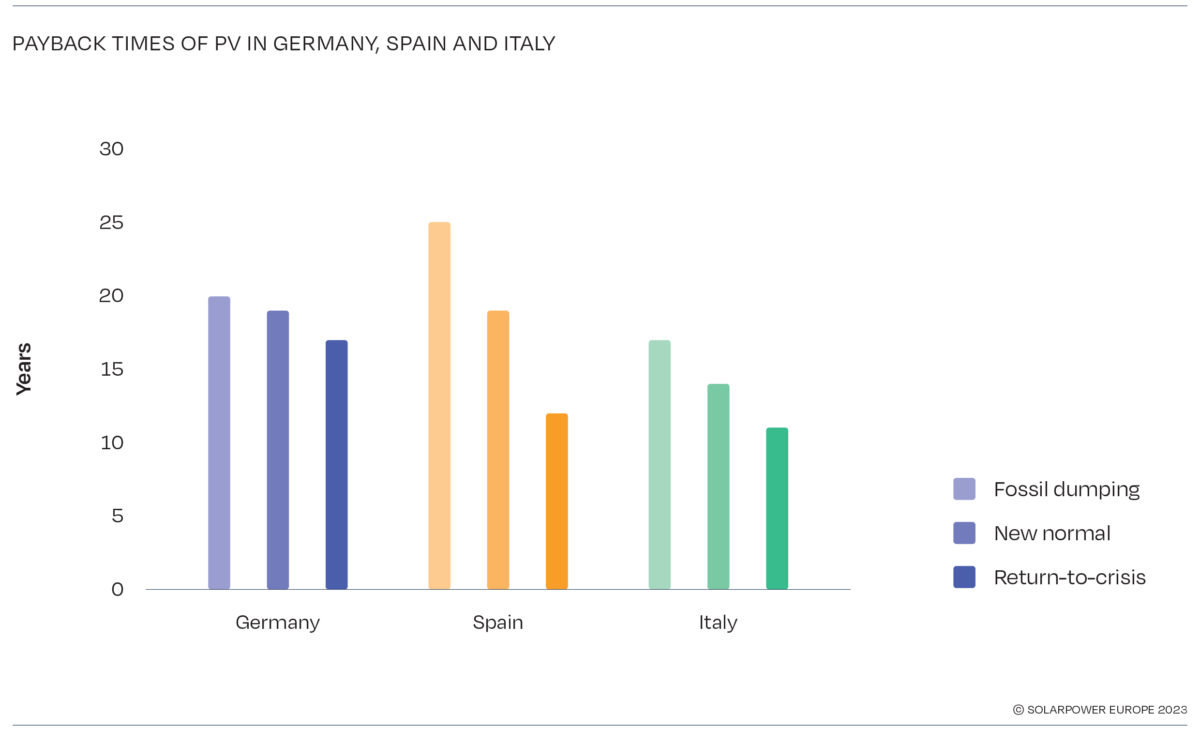SolarPower Europe has included an analysis of residential PV payback times in 2022 in a recently published report on the symbiotic effect of rooftop solar and heat pumps.
The energy modeling, conducted by German-based consultancy Energy Brainpool, considers three different scenarios. It reviewed a “fossil dumping” scenario, under which global gas demand falls dramatically, leading to low fossil fuel prices. It looked at a “new normal” scenario, under which gas prices remain at current levels. And it also looked at a “return to crisis” scenario, under which gas prices return to the high prices of fall 2021. The residential PV systems were assumed to have capacities of 8 kW in Germany and 7 kW in Spain and Italy.
The model indicates PV payback times of around 18 years in Germany, 19 in Spain, and 14 in Italy, under the “new normal” scenario. The “fossil dumping” scenario shows payback times of 20 years, 25 years, and 17 years, respectively. Rooftop solar has the lowest payback time under the “return to crisis” scenario, at 17 years in Germany, 12 years in Italy, and 11 years in Spain.
“We were surprised by the results for payback times, as we often hear that payback time is lower than 10 years,” Christophe Lits, market analyst for SolarPower Europe, told pv magazine. “The model takes everything into account as of 2022: the capex price, electricity price, interest rates, feed-in tariffs, rebate schemes … there’s no magic science as to how we computed the payback time, we looked at how much you paid for the [PV system and its] installation, and how much electricity from the grid you didn’t have to buy. Then we just looked at how many years of those savings it would take to equal the total capex price.”
Three major factors played into the high payback times for PV in 2022, according to Liets: high capex, assumed at €1,600 ($1,742)/kW excluding value-added tax, lower electricity prices in years following 2022, and high interest rates for those using loans to purchase the PV system.
“When we talk to installers about payback times, they aren’t really looking at all the differences in subsidies or increase in capex prices, they’re basically looking at how much electricity you save by installing PV – when you look in more detail, the results are more precise,” said Lits, in reference to the stark difference between the often suggested 10 years payback time and the analysis results.
After publishing the report, SolarPower Europe and Energy Brainpool also conducted a sensitivity analysis of payback times with varying capex values.
“For capex values seen four to two years ago, in the range of €1,200/kW or even €1,000/kW in Spain, the payback times return to around 10 years in Germany and seven in Spain,” said Lits.
The report concludes that capex support is crucial to reduce payback times “in an inflationary environment with high interest rates and high labor costs.” It proposes several ways for member states to provide capex support, noting that a 30% in capex support reduces payback times for PV and heat pumps by six to eight years in Germany, Italy, and Spain.
This content is protected by copyright and may not be reused. If you want to cooperate with us and would like to reuse some of our content, please contact: editors@pv-magazine.com.



Borrowing money to install solar will do this. Just purchase a small system outright, and add panel as you can when the savings roll in.
In Canada, the average 3000 Sq ft home will use a minimum of $2500 of hydro per year, if everything except the furnace is electric. I save $2000 per year with my array. Based on that, just in hydro savings alone, a $30,000 array that’s 11 kw, will be totally paid for in 15 years. I got a three year old system installed, so my payback from install is less than ten years.
Irish conditions according to government statements:
https://www.thejournal.ie/vat-rate-on-supply-installation-solar-panels-to-be-abolished-6034863-Apr2023/
” Ryan said the move will give people cheaper renewable energy and reduce their payback period by nearly a year, from seven years to 6.2 years (based on average 4.5KW installation).”
A balcony PV system in Germany has an amortisation of some 5 years as ths magazine reports:
https://www.pv-magazine.de/2021/12/15/htw-berlin-und-indielux-veroeffentlichen-onlinerechner-fuer-stecker-solar-geraete/
The energetic amortisation for large PV installation is at around 0.4 – 1.4 years … as this magazine reports:
https://www.pv-magazine.de/2021/07/28/fraunhofer-ise-energetische-amortisationszeit-fuer-photovoltaik-dachanlagen-liegt-weltweit-zwischen-044-und-142-jahren/
I consider the report by Energy Brainpool as non-recyable waste.